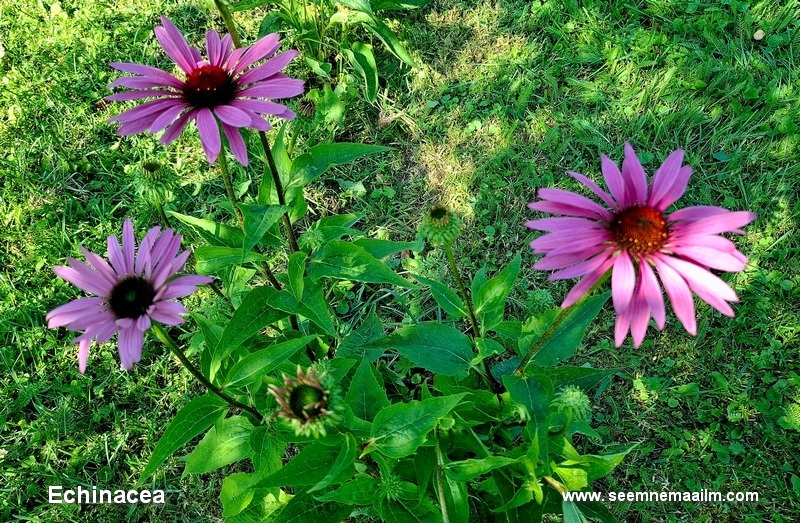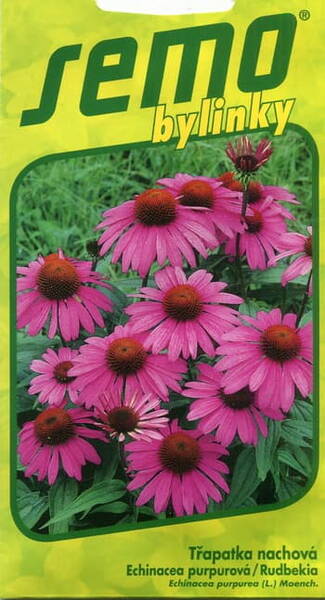Ex Tax: 1.45€
Perennial herbaceous plant 60-100 cm high. Stems are simple, branching at the top. Flower baskets are large, with a three-row wrapper of lanceolate leaves. Blooms in July-August. Flower baskets are used as medicinal raw materials (harvested in July-August) and rhizomes with roots (harvested in late autumn). The plant has a high bactericidal effect and is used as an antiseptic, and the water infusion has an analgesic effect.
Echinacea preparations have a stimulating effect on the central nervous system, they are used in cases of physical and mental exhaustion.
Sowing time: May, August, September.
Harvest time: July, August.
Planting method: open ground.
Plant height: 60-100 cm.
Distance between plants: 60 cm.
Distance between rows: 70 cm.

Sampson root, eastern purple coneflower, purple coneflower, black sampson, comb-flower. Bot. syn.: Brauneria purpurea (L.) Britt., Rudbeckia purpurea L.
* Echinacea, due to its healing properties, deservedly takes pride in place among medicinal plants.
Echinacea is also called the "blood cleanser", but pure blood is a healthy body. Echinacea actively cleanses the lymphatic system, blood, kidneys and liver. Echinacea does not treat the consequences of the disease, but its root causes and, importantly, does not have side effects.
Echinacea is a plant of the Echinacea family that grows wild in America and is found in our country as an ornamental flower crop. At home, in Latin America, echinacea is very popular among the indigenous population. Indians prepare drinks, compresses and infusions from it. It is believed that echinacea is the most valuable medicinal plant growing in those places. The underground parts of Echinacea saved from death more than one thousand Indians bitten by poisonous snakes.
Native American tribes along the Missouri River have used echinacea roots to heal wounds since time immemorial. The Omaha and Ponca called echinacea "comb flower" because the core was used by them to comb their hair.
"Snakeroot" was the name given to the plant by the Crow, Pawnee, Hidatsa, and Comanche tribes and was used for rattlesnake bites. The Indians treated echinacea with cough, sore throat, toothache and gastrointestinal pain. The decoction washed the eyes and purulent wounds. Echinacea leaf tea was used to treat arthritis, rheumatism, mumps, measles and burns, as it had healing properties. Echinacea grass was fed to livestock so that the animals would gain weight better. The Indians considered echinacea the strongest antidote for snake bites and poisonous insects. They knew a lot about the healing properties of Echinacea.
White invaders from the new world destroyed the natives of America, using vodka and other tricks. Then they took their lands. And at the same time, the experience of practical life and the use of the healing properties of echinacea was practically lost. Only a few settlers were able to learn from the Indians and use them in everyday life. As an example, in Oklahoma, during illnesses, animals were fed with echinacea, and soon the animals recovered. Earlier, on the same lands, the Indians treated their animals in this way ...
The mass collection of wild-growing echinacea occurred at the end of the 19th century. In 1897, students at the University of Kansas were earning 25 cents a pound while picking its roots. Newspapers in 1902 reported that about 200,000 pounds of dried roots were harvested in northwest Kansas at a price of 50 cents a pound of echinacea. More than two million living plants were dug up in this way, worth $100,000! Then the species of echinacea was put on the verge of extinction. But the healing properties of echinacea have been appreciated again!
Research in the 20th century found that the effectiveness of echinacea preparations does not follow the principle, "the more the better." Increasing the dose of the drug does not lead to an increase, but even to a decrease in immunity - somewhere after 2 weeks of constant use!
There are nine known species of Echinacea, all of which are native to North America. Today, this beautiful culture is the most popular medicinal plant in the world. The enormous healing power and extraordinary breadth of therapeutic applications brought her such fame.
Echinacea quickly and effectively, without addiction and side effects, treats a huge number of diseases.












